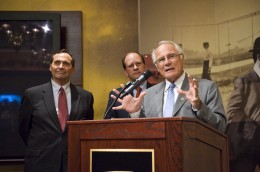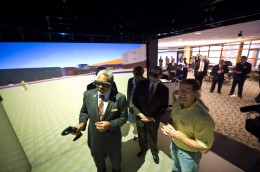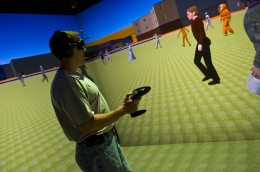
With Chancellor Jim Petro and Senator Chris Widener at his side, Wright State President David R. Hopkins talked about the value of the entrepreneurial spirit in higher education at the July 18 news conference.
Wright State University will lead a new initiative with industry to grow Ohio’s aerospace and defense workforce, officials announced today.
Ohio will invest $11.4 million in the effort over two years with funding contained in the biennial budget recently signed by Gov. John Kasich.
The Wright State Research Institute, through its Defense Aerospace Graduate Studies Institute, will work with its sister institutions of higher education to build an aerospace curriculum that links education and training, research, technology commercialization and new job creation for the Dayton Region and the State of Ohio, state lawmakers announced in a press conference at the university.
State Sen. Chris Widener, R-Springfield, said the funding will build on the successes already achieved to create high-quality aerospace and defense jobs in the region.

Distinguished guests toured the Appenzeller Visualization Laboratory at Wright State after the news conference.
“With Wright State’s leadership, this money is aimed at increasing research that results in the commercialization of aerospace technology and at boosting graduate education to fill the pipeline with talent to feed emerging and growing businesses,” Widener said.
“This is a great example of how a university can partner with private businesses in order to fuel economic development,” said Jim Petro, chancellor of the Ohio Board of Regents. “Wright State University will serve as the lead for institutions in the University System of Ohio along with the Air Force Research Laboratory and Wright-Patterson Air Force Base in developing programs for an emerging workforce that align with aerospace and defense-related needs. It is the kind of thinking that comes naturally for universities. With Ohio’s wealth of good colleges, it can be a blueprint for economic success.”
“Through our Wright State Research Institute, Wright State is honored and pleased that the Ohio Senate and the State of Ohio have asked us to serve as the lead on this important workforce development initiative with our regional and state partners to create new jobs,” said Wright State President David R. Hopkins.

A Wright State University researcher searches for a suspected terrorist in a virtual urban environment in the Appenzeller Visualization Laboratory. Such capabilities enable the Wright State Research Institute to leverage the investment state and university officials announced Monday, July 18.
He continued, “We accept the challenge and will work aggressively to turn this research funding into new technologies, products and jobs. In order to strengthen ties between the graduate curriculum and the aerospace industry, we will work with our sister institutions through our newly created Defense Aerospace Graduate Studies Institute to fill the pipeline with students to support the needs of existing and emerging businesses. I want to thank Governor Kasich, Chancellor Jim Petro, Senators Chris Widener and Bill Beagle and the rest of our delegation who voted for the state budget to provide the Dayton region with the resources we need to continue our work to retain and grow missions at Wright-Patterson.”
“The Wright State Research Institute’s Human Performance Consortium will play an important role in this initiative” said S. Narayanan, executive director of the Wright State Research Institute and professor and dean, College of Engineering and Computer Science at Wright State.
The consortium currently includes the AFRL/711th Human Performance Wing, Dayton Development Coalition, Science Applications International Corp., or SAIC; Radiance Technologies, Kettering Health Network, Applied Research Associates, Advanced Technical Intelligence Center, SelectTech Geospatial, Infoscitex, UES, Booz/Allen/Hamilton, Aptima and other aerospace companies and universities in Ohio.
The consortium is supporting the 711th Human Performance Wing and AFRL at Wright-Patterson under a five-year, $6.4 million research contract awarded in December. Much of the work is related to neuromedical imaging and advanced intelligence.
“This investment will allow the consortium to expand its scientific research, technology commercialization and workforce development to continue to support the research partnership between Wright State and the Air Force Research Laboratory,” said Ryan Fendley, director of Wright State Research Institute.
The Wright State Research Institute is the university’s gateway to its research capabilities and a mechanism for creating collaborative teams to solve problems facing the Air Force, aerospace industry and others.

 Bags, boards and bonding
Bags, boards and bonding  More than 1,000 students to graduate at Wright State’s fall commencement ceremonies
More than 1,000 students to graduate at Wright State’s fall commencement ceremonies  Wright State’s Take Flight Program helps students soar high
Wright State’s Take Flight Program helps students soar high  Wright State Police Department delivers major donation to Raider Food Pantry
Wright State Police Department delivers major donation to Raider Food Pantry  Wright State engineering and computer science students earn prestigious federal SMART Scholarships
Wright State engineering and computer science students earn prestigious federal SMART Scholarships 